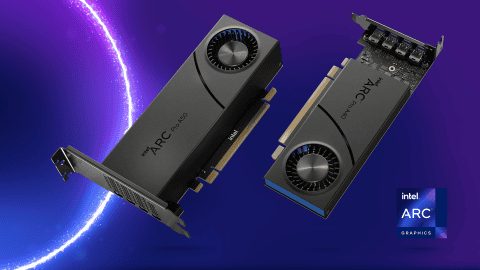Intel’s next-gen Arc Battlemage GPUs are coming soon. These graphics cards aim to shake up the market with new tech. Intel originally planned to release Battlemage GPUs in late 2024, but now it looks like early 2025 is the soonest we will see them. The cards have generated considerable buzz in the tech world with rumors that AMD doesn’t care much about the high-end consumer market and NVIDIA seemingly pricing a lot of people out of the market with recent cost increases.
Rumors suggest that Battlemage, Intel’s upcoming graphics card, will bring significant performance improvements and enhanced features to the market. Details are scarce, but anticipation for these next-generation GPUs is high. Intel aims to launch the new GPUs, which will use TSMC’s 4nm process, before the holiday season to increase sales. The Battlemage GPUs are expected to come in various sizes, possibly with 28 or 56 Xe2 cores, positioning Intel to compete with other major players in the graphics card industry.
Intel Arc Battlemage GPUs: The Next Generation of Graphics Power
Expected Launch and Delay
The Intel Arc Battlemage GPUs were initially anticipated for a late 2024 release. However, recent rumors suggest a potential delay, pushing the launch to sometime in 2025, possibly even early in the year. This delay is speculated to be due to a combination of ongoing architectural refinements and a strategic move to better position Battlemage against upcoming offerings from Nvidia and AMD.
Rumored Specifications and Performance
While official details are scarce, leaks and speculations point to a significant performance leap compared to the current Alchemist generation. Battlemage GPUs are rumored to boast improved ray tracing capabilities, enhanced AI acceleration, and potentially even support for 8K gaming. A flagship model with up to 64 Xe-Cores and a substantial 20GB of VRAM is also rumored to be in the works, aiming to rival high-end graphics cards from competitors.
| Model (Rumored) | Xe-Cores | VRAM | Memory Bus | Clock Speed (GHz) | L2 Cache (MB) |
|---|---|---|---|---|---|
| BMG G10 (Low-end) | 20 | 12 GB GDDR6 | 128-bit | 1.8 | 8 |
| BMG G21 (Mid-range) | 24 | 12 GB GDDR6 | 192-bit | 1.8 | 8 |
| BMG G31 (High-end) | 40-56 | 16-20 GB GDDR6 | 256-bit | 2.5-3.0 | TBD |
Please note that these specifications are based on rumors and leaks. Official specifications may differ when Intel releases the Arc Battlemage GPUs.

Potential Improvements
- Enhanced Ray Tracing: Battlemage is expected to feature dedicated hardware for ray tracing, delivering more realistic lighting and shadows in games.
- AI Acceleration: Improved AI capabilities could lead to advancements in features like DLSS (Deep Learning Super Sampling), enabling higher resolutions and smoother frame rates.
- 8K Gaming Support: The potential inclusion of 8K gaming support would position Battlemage at the forefront of cutting-edge display technologies.
Speculation vs. Reality
While the rumors are exciting, it’s important to remember that these are still just speculations. Intel has not officially confirmed any specific details about Battlemage GPUs, including their release date or exact specifications.
| Feature / Model | Intel Arc Battlemage (Rumored) | NVIDIA GeForce RTX 50 Series (Rumored) | AMD Radeon RX 8000 Series (Rumored) |
|---|---|---|---|
| Launch Date | Early 2025 | Late 2024/Early 2025 | Late 2024/Early 2025 |
| Architecture | Xe2-HPG | Blackwell | RDNA 4 |
| Manufacturing Process | TSMC N3 (rumored) | TSMC 4N (rumored) | TSMC 5nm/3nm (rumored) |
| Flagship Model | BMG G31 | RTX 5090 | RX 8900 XT |
| Estimated Performance | High-end: ~RTX 4080 | Top-tier, surpassing RTX 4090 | Top-tier, targeting RTX 4090 |
| Ray Tracing | Improved dedicated hardware | Further advancements, DLSS 3.5 | Enhanced ray tracing cores |
| AI Acceleration | Enhanced Xe Matrix Extensions (XMX) | New Tensor Cores, improved DLSS | AI accelerators integrated into core design |
| Memory | Up to 20 GB GDDR6 | Up to 24 GB GDDR7 (rumored) | Up to 32 GB GDDR7 (rumored) |
| Power Consumption | TBD, expected improvements over Alchemist | TBD, focus on efficiency | TBD, rumored to be power-hungry |
| Key Advantages | Potentially competitive pricing, strong XeSS upscaling | Market leader, mature software ecosystem, ray tracing prowess | Multi-chip module (MCM) design, potentially high performance |
| Target Audience | Mainstream to enthusiast gamers seeking value | Enthusiast gamers and professionals | High-end gamers and content creators |
Disclaimer: This table is based on currently available rumors and leaks. Official specifications and performance may differ upon release.
The Road Ahead
Intel’s Arc Battlemage GPUs hold the promise of shaking up the graphics card market with improved performance, features, and potentially competitive pricing. The delay, while disappointing for some, may ultimately lead to a more polished and refined product at launch. As we eagerly await official announcements from Intel, the anticipation for Battlemage continues to build.
Key Takeaways
- Intel Arc Battlemage GPUs are set to launch in late 2024 or early 2025
- The new GPUs will use advanced 4nm tech for better performance
- Intel aims to offer a range of models to compete in the graphics card market
Technology and Specifications
Intel’s Arc Battlemage GPUs bring new tech to the table. These cards aim to boost gaming and graphics performance with fresh designs and features.
Architecture and GPU Design
Battlemage GPUs use the Xe2-HPG architecture. This new design builds on Intel’s earlier Xe graphics tech. It’s made on TSMC’s N4 process which allows for smaller more efficient chips.
The GPUs have more Xe Cores than before. These are the main processing units that handle graphics tasks. Each core has improved Vector Engines for faster calculations.
Clock speeds are also higher. This means the GPU can do more work in less time. The exact speeds vary between models but are a step up from past Intel cards.
Memory and Performance Features
Battlemage cards come with more VRAM. This extra memory helps with high-res textures and large game worlds. The memory subsystem is faster too letting data move quicker.
The L2 cache has grown. This on-chip storage speeds up data access for better performance. Ray tracing hardware has also been upgraded. Games can now have more realistic lighting and reflections.
Intel has added new AI features. These help with tasks like upscaling making games look sharper without hurting performance.
Software and Driver Support
Driver updates are key for GPU performance. Intel is working to improve their software support. New drivers come out often with fixes and speed boosts for games.
The company has made tools to help game devs. These let them get the most out of Battlemage GPUs. Features like XeSS upscaling are now in more games.
Intel’s control panel got an update too. It’s easier to use and has more options for tweaking graphics settings. The goal is to make using Battlemage cards simple for all users.

Market Position and Competition
Intel’s Arc Battlemage GPUs aim to shake up the graphics card market. They face stiff rivalry from Nvidia and AMD but bring new choices for gamers and PC users.
Comparison to Nvidia and AMD
Intel’s Battlemage GPUs are set to compete with Nvidia and AMD offerings. These cards will likely target mid-range to high-end segments. Intel hopes to improve on its first Arc Alchemist cards which had mixed reviews.
Battlemage might match or beat some current Nvidia and AMD models in speed. But top-tier cards from rivals could still lead in raw power. Intel needs to fix driver issues that plagued Alchemist to win trust.
The GPU market is tough to break into. Nvidia holds the lead while AMD is a strong second. Intel must prove Battlemage can deliver solid gaming performance to gain ground.
Expected Performance in Gaming
Battlemage GPUs are built for gaming. They should run modern games well at high settings and resolutions. Early reports hint at big gains over Arc Alchemist cards.
These new GPUs might handle ray tracing better than their predecessors. This could help Intel compete in high-end gaming. Battlemage may also boost AI features for better frame rates.
Intel has time to fine-tune drivers before launch. This could lead to smoother gameplay and fewer bugs. Good drivers are key for Intel to win over gamers who want hassle-free experiences.
Pricing and Availability
Intel may price Battlemage GPUs to undercut rivals. This could make them an appealing choice for budget-conscious gamers. Prices might range from $200 to $500 based on past Intel cards.
The launch date is not set but could be in late 2024 or early 2025. This timing might coincide with big shopping events like Black Friday. A holiday season release could boost sales.
Supply could be an issue at first. New GPU launches often face shortages. Intel will need to ensure enough stock to meet demand. Wide availability will be crucial for Battlemage’s success in the market.







